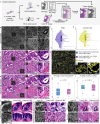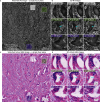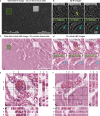Revealing 3D microanatomical structures of unlabeled thick cancer tissues using holotomography and virtual H&E staining
- PMID: 40404616
- PMCID: PMC12098747
- DOI: 10.1038/s41467-025-59820-0
Revealing 3D microanatomical structures of unlabeled thick cancer tissues using holotomography and virtual H&E staining
Abstract
In histopathology, acquiring subcellular-level three-dimensional (3D) tissue structures efficiently and without damaging the tissues during serial sectioning and staining remains a formidable challenge. We address this by integrating holotomography with deep learning and creating 3D virtual hematoxylin and eosin (H&E) images from label-free thick cancer tissues. This method involves measuring the tissues' 3D refractive index (RI) distribution using holotomography, followed by processing with a deep learning-based image translation framework to produce virtual H&E staining in 3D. Applied to colon cancer tissues up to 50 µm thick-far surpassing conventional slide thickness-this technique provides direct methodological validation through chemical H&E staining. It reveals quantitative 3D microanatomical structures of colon cancer with subcellular resolution. Further validation of our method's repeatability and scalability is demonstrated on gastric cancer samples across different institutional settings. This innovative 3D virtual H&E staining method enhances histopathological efficiency and reliability, marking a significant advancement in extending histopathology to the 3D realm and offering substantial potential for cancer research and diagnostics.
© 2025. The Author(s).
Conflict of interest statement
Competing interests: D.R., D.A., H.C., H.-S.M. and Y.K.P. have financial interests in Tomocube, a company that commercializes holotomography instruments. T.H.H. is a scientific co-founder of Kure.ai Therapeutics and its subsidiary, Kure.S. He holds no official roles in the companies and receives no salary or consulting fees. The companies did not influence the design, execution, or interpretation of this study. All other authors declare no competing interests.
Figures








References
-
- Wang, L., Li, M. & Hwang, T. H. The 3D revolution in cancer discovery. Cancer Discov.14, 625–629 (2024). - PubMed
MeSH terms
Substances
Grants and funding
LinkOut - more resources
Full Text Sources
Medical

